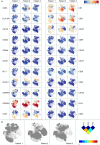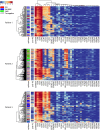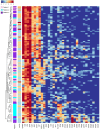Heterogeneity of circulating CD8 T-cells specific to islet, neo-antigen and virus in patients with type 1 diabetes mellitus
- PMID: 30089176
- PMCID: PMC6082515
- DOI: 10.1371/journal.pone.0200818
Heterogeneity of circulating CD8 T-cells specific to islet, neo-antigen and virus in patients with type 1 diabetes mellitus
Abstract
Auto-reactive CD8 T-cells play an important role in the destruction of pancreatic β-cells resulting in type 1 diabetes (T1D). However, the phenotype of these auto-reactive cytolytic CD8 T-cells has not yet been extensively described. We used high-dimensional mass cytometry to phenotype autoantigen- (pre-proinsulin), neoantigen- (insulin-DRIP) and virus- (cytomegalovirus) reactive CD8 T-cells in peripheral blood mononuclear cells (PBMCs) of T1D patients. A panel of 33 monoclonal antibodies was designed to further characterise these cells at the single-cell level. HLA-A2 class I tetramers were used for the detection of antigen-specific CD8 T-cells. Using a novel Hierarchical Stochastic Neighbor Embedding (HSNE) tool (implemented in Cytosplore), we identified 42 clusters within the CD8 T-cell compartment of three T1D patients and revealed profound heterogeneity between individuals, as each patient displayed a distinct cluster distribution. Single-cell analysis of pre-proinsulin, insulin-DRIP and cytomegalovirus-specific CD8 T-cells showed that the detected specificities were heterogeneous between and within patients. These findings emphasize the challenge to define the obscure nature of auto-reactive CD8 T-cells.
Conflict of interest statement
The authors have declared that no competing interests exist.
Figures




References
-
- Coppieters KT, Dotta F, Amirian N, Campbell PD, Kay TW, Atkinson MA, et al. Demonstration of islet-autoreactive CD8 T cells in insulitic lesions from recent onset and long-term type 1 diabetes patients. J Exp Med. 2012;209(1):51–60. 10.1084/jem.20111187 ; PubMed Central PMCID: PMCPMC3260877. - DOI - PMC - PubMed
-
- Tan S, Li Y, Xia J, Jin CH, Hu Z, Duinkerken G, et al. Type 1 diabetes induction in humanized mice. Proceedings of the National Academy of Sciences of the United States of America. 2017;114(41):10954–9. Epub 2017/09/07. 10.1073/pnas.1710415114 ; PubMed Central PMCID: PMCPMC5642714. - DOI - PMC - PubMed
-
- Pinkse GG, Tysma OH, Bergen CA, Kester MG, Ossendorp F, van Veelen PA, et al. Autoreactive CD8 T cells associated with beta cell destruction in type 1 diabetes. Proceedings of the National Academy of Sciences of the United States of America. 2005;102(51):18425–30. Epub 2005/12/13. 10.1073/pnas.0508621102 ; PubMed Central PMCID: PMCPMC1317949. - DOI - PMC - PubMed
-
- Velthuis JH, Unger WW, Abreu JR, Duinkerken G, Franken K, Peakman M, et al. Simultaneous detection of circulating autoreactive CD8+ T-cells specific for different islet cell-associated epitopes using combinatorial MHC multimers. Diabetes. 2010;59(7):1721–30. Epub 2010/04/02. 10.2337/db09-1486 ; PubMed Central PMCID: PMCPMC2889772. - DOI - PMC - PubMed
Publication types
MeSH terms
Substances
LinkOut - more resources
Full Text Sources
Other Literature Sources
Medical
Research Materials

